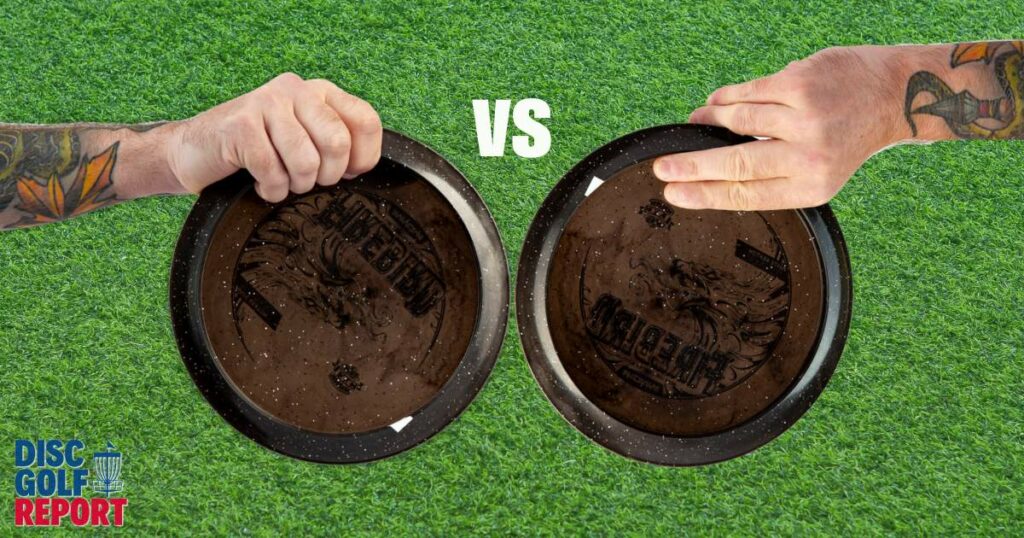Have you ever gotten into a fistfight on the course over an argument about forehand vs backhand?
No? Good. Me either. 😉
One question often sparks lively debate among players: is a disc golf forehand or backhand throw better for achieving maximum distance? This seemingly simple inquiry opens up a world of discussion as disc golfers from various backgrounds and skill levels bring their unique experiences and preferences to the table.
While some players swear by the power and control of a forehand throw, others advocate for the traditional and often more powerful backhand technique. This division of opinion isn’t just casual banter at local courses; it’s a topic that has fueled extensive discussions and analyses in disc golf communities online.
In this article, we delve into the heart of this debate. We’ll explore the mechanics of both forehand and backhand throws, examine the role of muscle groups and off-axis torque, and consider how different disc choices might favor one style over the other. By breaking down the technical aspects and tapping into the collective wisdom of seasoned players, we aim to shed light on which throwing style might give you that extra edge in distance on the course.
Whether you’re a forehand enthusiast, a backhand proponent, or a player still finding your style, join us as we unravel this intriguing aspect of disc golf. Our journey through the nuances of forehand and backhand throws will enhance your understanding and help refine your approach to achieving maximum distance in your game.
Understanding the Mechanics of Forehand and Backhand Throws
In disc golf, mastering the mechanics of your throw is pivotal to achieving distance. Let’s delve into the nuances of forehand and backhand throws, each with its own unique characteristics.
Range of Motion
- Backhand: This throw involves a wider range of motion. The disc is pushed back behind the body and then fully extended outward, traveling a long distance from point A to point B before release. This extensive motion allows for greater momentum and energy transfer.
- Forehand: The forehand throw, in contrast, involves a shorter range of motion. The disc still moves back behind the body, but the forward motion covers less distance than the backhand before release. This shorter path can limit the power generated.
Learn more about range of motion from these disc golf YouTube channels.
Muscle Groups
- Backhand: The backhand throw leverages larger muscle groups more effectively. During this throw, players engage their legs, lats, hips, shoulders, and core. This holistic engagement allows for a more powerful, explosive movement.
- Forehand: The forehand primarily relies on arm muscles, particularly the forearm and wrist. While it still uses large muscle groups, they’re not as effectively engaged as in a backhand throw.
Off Axis Torque (OAT)
- Backhand: Generally, backhand throws are less prone to off-axis torque, leading to a more stable and predictable flight for the disc.
- Forehand: Forehand throws, due to the range of motion and wrist position, are more susceptible to OAT. This can result in wobble and instability during flight, potentially affecting distance and accuracy.
Understanding these mechanics is key to optimizing your throw for distance. Whether it’s the wide, power-generating arc of the backhand or the quick, sharp motion of the forehand, each has its place in any player’s game. The choice between them often comes down to personal style, physical strength, and the specific demands of the course.
Analyzing Off-Axis Torque (OAT) in Throws
Off Axis Torque in Backhand Throws
In backhand throws, off-axis torque (OAT) is generally less prevalent, leading to a more stable and predictable flight path for the disc. This stability is primarily due to the mechanics of the backhand throw, which allows for a smoother and more natural release.
The longer range of motion and the use of larger muscle groups contribute to a more controlled release, reducing the likelihood of the disc wobbling or deviating from its intended flight path.
Off Axis Torque in Forehand Throws
Forehand throws, on the other hand, are more susceptible to OAT. This is often due to the wrist position and the shorter range of motion involved in the throw. The forehand’s reliance on smaller muscle groups, particularly in the forearm and wrist, can lead to inconsistencies in the release.
This inconsistency is what causes the disc to experience off-axis torque, resulting in wobble and potentially less accuracy and distance. Additionally, the high-to-low motion common in forehand throws can further exacerbate these issues.
Understanding and managing OAT is crucial in disc golf, as it significantly affects the disc’s flight and, ultimately, the throw’s effectiveness. Players looking to optimize their throws for distance should focus on techniques that minimize OAT, adapting their form to ensure a cleaner release, whether they’re using a forehand or backhand throw.
The Role of Wrist Position and Movement
Wrist Movement in Backhand Throws
In backhand throws, the wrist plays a crucial role in generating spin and controlling the angle of release. A firm yet flexible wrist position allows for a snap at the end of the throw, which imparts additional spin and stability to the disc. This spin is key to achieving both distance and accuracy.
The natural arc of a backhand throw typically keeps the wrist aligned with the forearm, reducing the risk of off-axis torque and ensuring a smoother release.
Wrist Position in Forehand Throws
Forehand throws require a different approach to wrist position and movement. To execute a forehand throw effectively, the wrist must be fully supinated (palm up) at the point of release. This position is essential for a flat and clean release along the disc’s axis.
However, because the forearm is not commonly held in a supinated position in everyday activities, players often find their forearm and wrist rolling into a pronated position (palm down) as they release the disc. This inadvertent wrist roll can lead to off-axis torque, causing the disc to wobble and potentially turn over in flight.
Maintaining a consistent wrist position throughout the throwing motion is critical in forehand throws. It’s a skill that requires practice and attention to detail, as the natural tendency to roll the wrist can be challenging to overcome. By focusing on keeping the palm up throughout the throw and following through, players can minimize off-axis torque and improve the stability and distance of their forehand throws.
Best Disc Golf Discs for Backhand vs Forehand
Disc Selection for Backhand Throws
Discs for backhand throws can vary widely depending on the player’s skill level and throwing style. However, since backhand throws are less susceptible to off-axis torque and turning over, discs with a bit of turn (understable to stable) are often preferred.
These discs can achieve a fuller flight path, allowing for greater distance and a more predictable fade at the end of the throw. A prime example is the Innova Wraith, known for its balance of speed, glide, and stability, making it accessible and consistent for a wide range of players.
Disc Selection for Forehand Throws
When it comes to forehand throws, disc selection is particularly crucial due to the throw’s susceptibility to off-axis torque. Players often favor more overstable discs for forehand throws as they are more forgiving of errors in release angle and can combat the tendency to turn over.
Overstable discs are going to be your best option, and Innova has some great driver options. These discs are designed to withstand high power and off-axis torque, providing a reliable fade even when thrown with a forehand.
Understanding the characteristics of different discs and how they interact with each throwing style is essential in disc golf. While there’s a general tendency towards certain types of discs for forehand and backhand throws, personal preference and throwing technique play a significant role.
Experimenting with various discs and observing their flight patterns in both forehand and backhand throws can help players find the best match for their style and enhance their overall game.
To Recap
Disc golf is as much an art as it is a sport. It’s about finding harmony between power, precision, and strategy. While backhand throws might generally offer more distance for most players, the forehand has its unique advantages and applications. The key is to develop proficiency in both styles, allowing for adaptability and versatility on the course.
It’s clear that the debate between forehand and backhand for distance is more than just a technical discussion—it’s a testament to the rich complexity and endless learning opportunities that disc golf offers. So, grab your disc golf bag, head to the course, and keep pushing the boundaries of your game!
Oh, and for the record – no distance contests have ever been won throwing forehand. Check out one of the best backhand drivers Simon Lizotte and try to mirror his form!
Want more disc golf content? Check out our latest disc retriever review!



